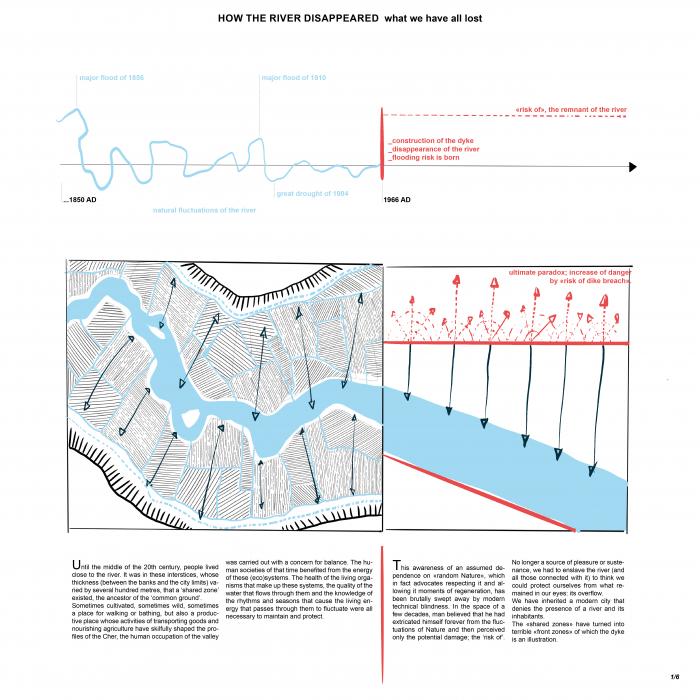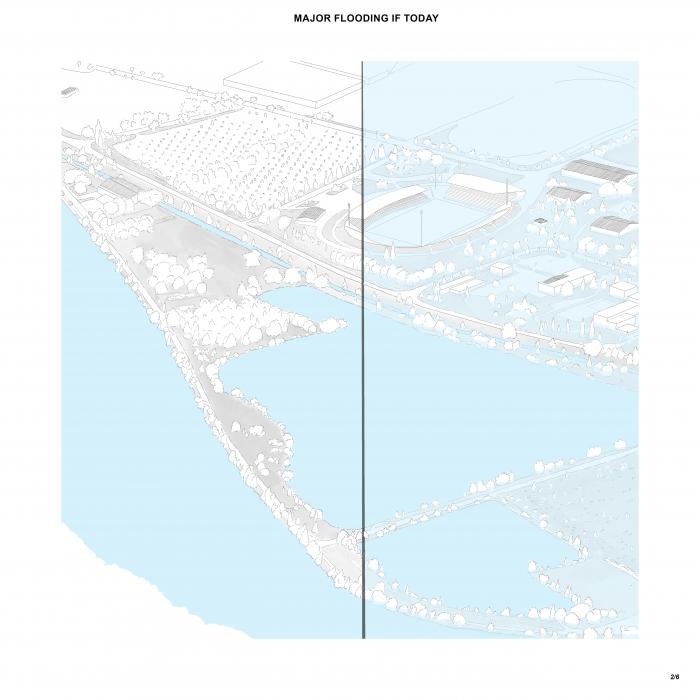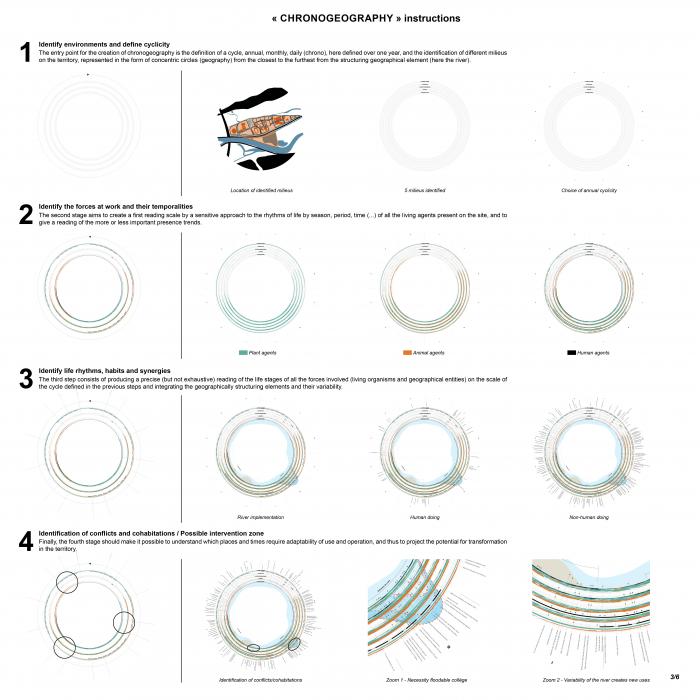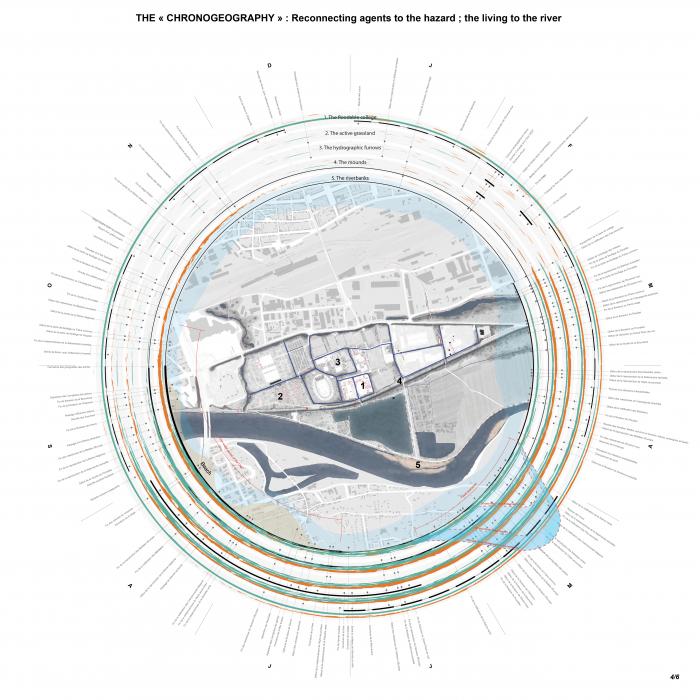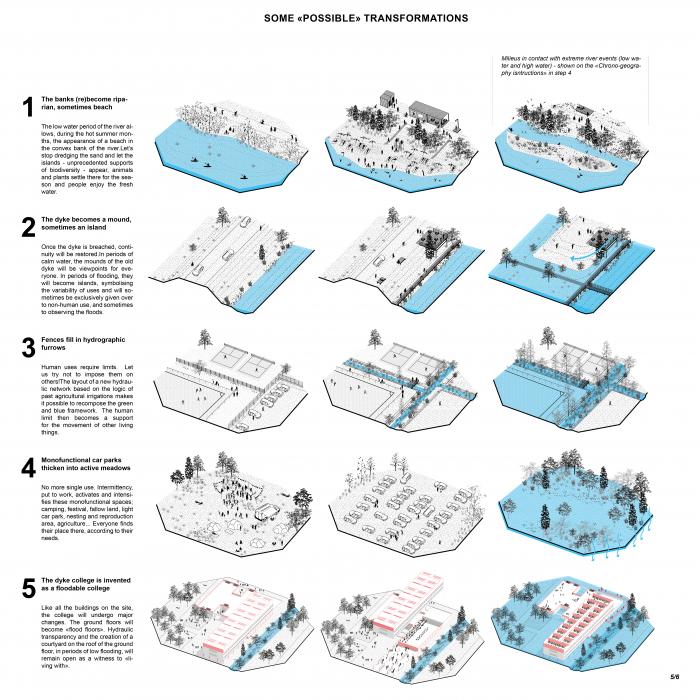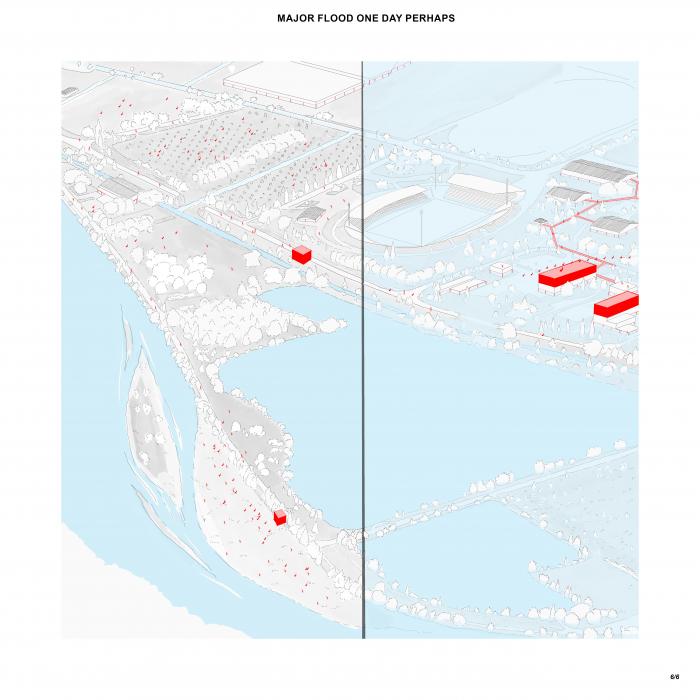On the banks of the Cher, a French river, the legacy of modernity separates; humans and non-humans ignore each other, sometimes even clash. Under the threat of flooding, the dam has pushed the river away, making us almost forget its presence.
Challenge? Accepting the fluctuations of the river to reconnect the living. To allow "common ground", a recognition between each of the forces involved: the cycles of living, human activities and the river itself in its variability, high and low water.
Loire Valley Drainage Bassin
On the banks of the Cher (a French river), the heritage of modernity separates; humans and non-humans ignore each other, sometimes even clash. Under the threat of flooding, the dam has pushed the river away, making us almost forget its presence.
We postulate that the level of denial and exploitation of a structuring geographical element (here a river) by a human society influences the capacity of a territory to allow quality relationships between living beings. How can we allow everyone (human, plant and animal) a dignified welcome? This work, through the prism of a return to -and from- the river, makes the bet that an understanding is possible but above all that it is absolutely necessary.
Questioning the notion of "risk of" is therefore a prerequisite for all actions. The "risk of" has a perverse effect; that of sacrificing the "river" entity for the benefit of a relative "safety". In order to protect ourselves from this famous "risk of", we therefore refuse everything that the river offers (energy, freshness, softness, etc.), and deny all those who live in it. The idea is not to deny reality - a flood is possible - but to admit our responsibility in the resulting danger. The hazard is natural, the risk is human.
"Project process"; We had to abandon design automatisms, open up to other living beings, and shape new tools to admit uncertainty.
"Chrono-geography", as a tool, initiates a project-process based on an inclusive and open diagnosis with clear objectives: to sustainably reconnect humans to the river, to the milieus and to other living beings.
The "possibilities" that result from these dynamics and translate with caution - but a lot of energy - the ambitions of actions on the territory.
In the image of its structuring geographical role, the river will be present as a thread in all the texts.It will carry with it all the philosophical, sociological, biological, etc. sediments necessary to constitute the landscapes of tomorrow.
Let's open the dike!
Please highlight how the concept/idea can be exemplary in this context
River sustainability; beneficial dependence, energy circularity and resilience
Sustainability, when invoked for environmental reasons, forces us to be very careful. It is no longer a question of seeing the environment as a "resource" to be consumed, but of entering into resonance with the "energies", the "forces" that run through it. This approach makes it possible to think of a virtuous circle, because the energies mobilised nourish a living system, unlike modern principles based on fossil resources which tend towards the inert (the dam, large infrastructures). The biological process of living beings has the formidable characteristic of reducing entropy locally. This capacity to constantly, and not without effort, maintain a certain internal coherence despite external pressures, is unique. By using life as the driving force, the process becomes sustainable, because it is then in turn alive.
If energy circularity is one of the main forces of our process, the inclusion of the river, through its randomness, brings the notion of uncertainty to the heart of our systems and shifts us from a general desire for sustainability to the vital necessity of resilience. In a lucid 1973 article in Science, the ecologist Holling extols openness to the 'unexpected' as the absolute condition for system resilience.
The state of resilience is organised in several stages. Before the unexpected event, a gradual physical and psychological transformation must be prepared and accompanied. It is no longer a question of adapting a territory to human uses but of adapting existing structures to the evolutionary and intrinsic mutability of milieux. In the end, it is no longer a question of developing the site but rather of initiating the conditions for its changes of state over the seasons and years. It is thus to recognise the value of working with the river, and not against it, the opportunity to meet it, to appreciate it and to love it, even in its most extreme moods.
Please highlight how the concept/idea can be exemplary in this context
River Aesthetics; the beauty of entangled commons
The "common ground" will be formed with the "already there". When the fear of a "flood risk" has left our ranks, we will be able to open the dike and discover the "other side". At that point, everything will be left to be done. We will have to ask ourselves how we wish to inhabit this New World, what place we will give to the 'infrastructure' of the dike, to that of the motorway? We will have to inhabit the ruins of a conflict and, in the manner of a palimpsest and as our cities and our memory have always been built, we will transform on the immutable basis of the present and the structuring traces of the past. But today our era no longer has the luxury of losing itself in creating, it must urgently take care of what exists; we can no longer create spaces, we must take care of the milieus. We believe that this infrastructural legacy must be turned into a living milieu rather than a space of sterile energy confrontation.
This work is therefore concerned with blurring, blurring and revitalising boundaries, fringes, borders and edges; be they spatial, temporal or mental. Chrono-geography contributes to revealing in time, in co-creation with the citizens, the possible revitalizations to be activated in these interstices. Some ideas;
"Boundaries as a space for the expression of life". It will be a question of building relational spaces based on the identification of milieus and accompanying their development by providing the necessary space for the forces identified.
"Acupuncture to activate beauty". We will be able to stage amenities by erecting microstructures/follies/observatories/belvederes to enable everyone to identify their "places of beauty", to exercise their thoughts and sensibilities.
"Deploying intermittent relationships". A work of synchronisation between existing human uses and the rhythms of the identified forces is to be initiated.
We are therefore talking about an aesthetic of Care.
Please highlight how the concept/idea can be exemplary in this context
River inclusion; mental territories of sharing
Inclusion, by its strictest definition, is "the action of including something in a whole, a set". Faced with a territory where today everything is excluded, where people look at each other without seeing each other, live side by side without touching each other, live together without living together, inclusion cannot be a simple fact to be integrated into the project, it must be the driving force behind a methodology for the transformation of these territories.
When "living against" separates and excludes, living together can be built, learned and discovered through the implementation of educational processes. Let us imagine that the river is no longer a danger; let us transform the limits that separate into water furrows that cross, thus elaborating a territory of sharing by learning the rhythms and the variabilities of 'what is other than only human'. Faced with this complexity, the implementation of new tools must accompany this process. Chrono-geography, a central tool, is both the matrix and the guarantor of the project's inclusive approach.
This transformation is generated and developed by the accumulation of knowledge of the place, of those who use it and of their rhythm, and is progressively woven by the shared knowledge of all. Before transforming, let's relearn to observe, understand and share so as not to leave anything out.
Inclusion is therefore a process, not an end in itself. The search for post-design inclusion, as an end in itself, can indeed sometimes become paradoxically excluding when it emphasises differences; stairs and slopes, preferential rates, etc. This is why inclusion was at the genesis of the very design of our team. It is, subsequently, from an "inventory" of the living in the territory, that we want to integrate all the actors of the territory (elected officials, children, users, non-humans ...); making a common territory of sharing prior to the modifications of a physical territory.
Please highlight how this approach can be exemplary
"Possibilities"
The river is therefore a formidable vector of sustainable, inclusive and aesthetic vitality. How can we not wish it to flood our lives? Here are some "possibilities" for the transformation of five spaces which, when opened up to the river, become milieus;
The banks (re)become riparian, sometimes beach
The low water period of the river allows, during the hot summer months, the appearance of a beach in the convex bank of the river.Let's stop dredging the sand and let the islands - unprecedented supports of biodiversity - appear, animals and plants settle there for the season and people enjoy the fresh water.
The dyke becomes a mound, sometimes an island
Once the dyke is breached, continuity will be restored.In periods of calm water, the mounds of the old dyke will be viewpoints for everyone. In periods of flooding, they will become islands, symbolising the variability of uses and will sometimes be exclusively given over to non-human use, and sometimes to observing the floods.
Fences fill in hydrographic furrows
Human uses require limits. Let us try not to impose them on others!The layout of a new hydraulic network based on the logic of past agricultural irrigations makes it possible to recompose the green and blue framework. The human limit then becomes a support for the movement of other living things.
Monofunctional car parks thicken into active meadows
No more single use. Intermittency, put to work, activates and intensifies these monofunctional spaces; camping, festival, fallow land, light car park, nesting and reproduction area, agriculture... Everyone finds their place there, according to their needs.
The dyke college is invented as a floodable college
Like all the buildings on the site, the college will undergo major changes. The ground floors will become "flood floors". Hydraulic transparency and the creation of a courtyard on the roof of the ground floor, in periods of low flooding, will remain open as a witne
Real invention or a return to tradition?
Are the "common grounds" new places? For us, children of the late 20th century, certainly. But they have forgotten predecessors.
Until the middle of the 20th century, people lived close to the river. It was in these interstices, whose thickness (between the banks and the city limits) varied by several hundred metres, that a 'shared zone' existed, the ancestor of the 'common ground'.
Sometimes cultivated, sometimes wild, sometimes a place for walking or bathing, but also a productive place whose activities of transporting goods and nourishing agriculture have skilfully shaped the profiles of the Cher, the human occupation of the valley was carried out with a concern for balance. The human societies of that time benefited from the energy of these (eco)systems. The health of the living organisms that make up these systems, the quality of the water that flows through them and the knowledge of the rhythms and seasons that cause the living energy that passes through them to fluctuate were all necessary to maintain and protect. This awareness of an assumed dependence on "random Nature", which in fact advocates respecting it and allowing it moments of regeneration, has been brutally swept away by modern technical blindness. In the space of a few decades, man believed that he had extricated himself forever from the fluctuations of Nature and then perceived only the potential damage; the 'risk of'. No longer a source of pleasure or sustenance, we had to enslave the river (and all those connected with it) to think we could protect ourselves from what remained in our eyes: its overflow.
We have inherited a modern city that denies the presence of a river and its inhabitants.
The "shared zones" have turned into terrible "front zones" of which the dyke is an illustration. It is imperative that we allow these places of conflict to become "common ground" where our contemporary expectations and thousand-year-old ecosystems can coexist.
Continuations and opportunities
In July 2021, through the AMITER competition organised by the French Ministry of Ecological Transition, we proposed this reflection on the development of territories undergoing change and exposed to natural hazards. The invitation to build "common grounds" strongly attracted the attention of the local jury composed of municipal and regional elected officials. The idea of opening up the dike as the great common future event of our city - the outcome - made a strong impression. This shared enthusiasm was a real relief for us, because it is at the local level that most of the issues are at stake. It is through work on the ground, accompanied/accompanying local actors, that these transformations can be made. Schools, colleges and high schools will also be integrated into this field of reflection, cofabricating a common educational culture around the notion of living with hazards.
In this sense, we are currently preparing to make contact with the town hall and the local elected representatives of the territory to extend these reflections, to develop them together and to co-construct the implementation of the transformation of this territory.
If most of the issues are played out at the local political level, the State and its decentralised services are absolutely allies with whom to work. However, this competition has shown us how complex the political scales are to percolate. While the local jury chose us as winners, the (sovereign) national ministerial jury decided otherwise. We remain convinced that the local level is sovereign over its territory. We must therefore succeed in establishing a dialogue, by setting up educational workshops, building exchanges with all the actors in the territory, and other strategies to be invented to bring the different political levels active in the territory into play (from state institutions to the technical services of town halls); here again, we must find common ground.
The territories of the New European Bauhaus
If the context of the AMITER competition and the enthusiastic reception of the project by the local political scale represents the formidable possibility of having a place of experimentation at "scale 1", the territories of the New European Bauhaus commit us to a different but equally exciting and undeniably complementary strategy.
We are aware of the difficulty - but also the necessity - of setting up localised projects with regional, national and sometimes supranational components. We believe that the New European Bauhaus, by its European influence and its asserted will to seek the localized and non-generic "exemplary", detaches us from our physical project site but transports us into a territory of ideas that the local scale of realization does not always allow to reach.
Thus, and in this perspective, we would like the New European Bauhaus to be the support (or partner) for the following year, for the setting up of round tables, writing works, scientific publications, interventions in conferences/symposiums, workshops and thinking. In short, that it be a meeting and sharing ground, that all these localised initiatives (those of the "others" and our own) - and solitary de facto - find a common territory.
The New European Bauhaus is, for us, a territory of experimentation.
@Breton, 2022
Content licensed to the European Union.
